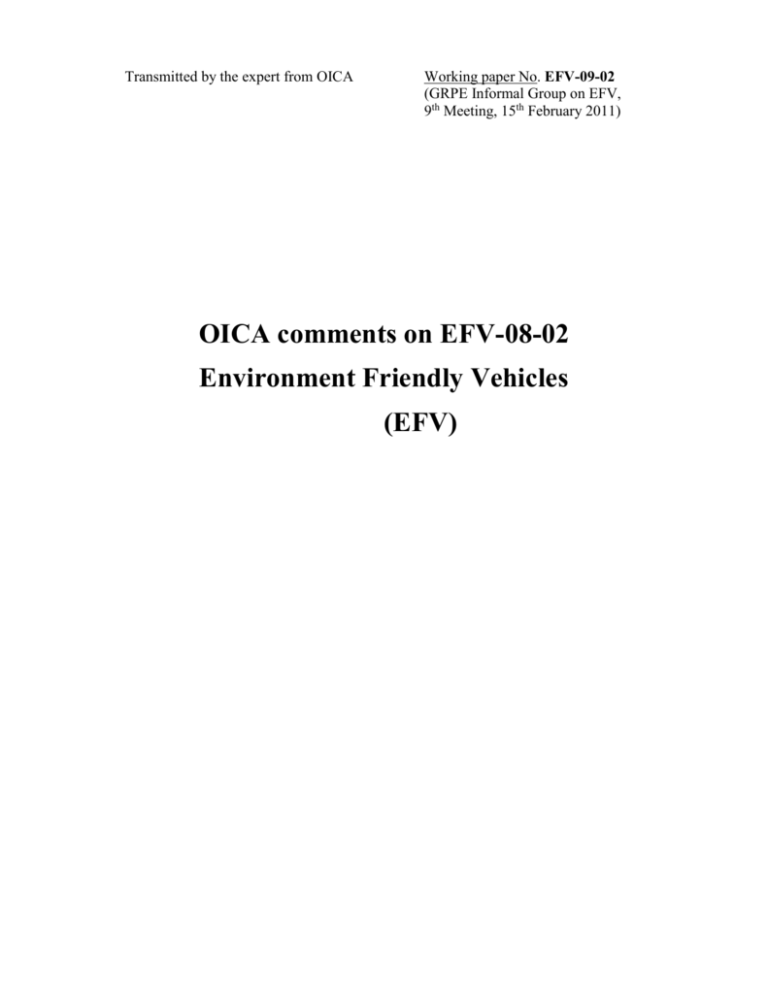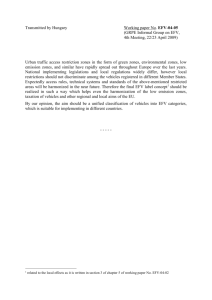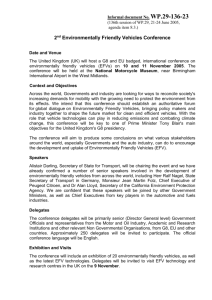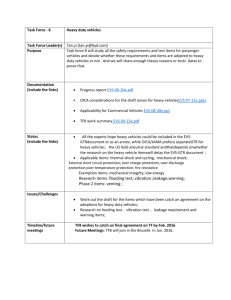OICA comments on EFV-08-02
advertisement

Transmitted by the expert from OICA Working paper No. EFV-09-02 (GRPE Informal Group on EFV, 9th Meeting, 15th February 2011) OICA comments on EFV-08-02 Environment Friendly Vehicles (EFV) OVERVIEW Cars are among the major consumers of energy in developed societies. They also make a major contribution to urban pollution, and to global warming. That is why the scientists, manufacturers and research institutions are making efforts continuously to reduce the pollution made during its production, usage and disposal of passenger cars. The basic design concept for environmentally friendly vehicle is based upon the following design strategies: Design the most efficient vehicle that uses the least energy for movement within the city, one that needs least energy to ride on road while delivering the required power efficiently and simply as possible. Define the boundaries of specific parameters to formulate the universal method for defining and evaluating the environment friendliness of a car including efficiency. As per the discussions from the 7th Informal Group meeting held in Geneva, in conjunction with the 60th GRPE session, the single score approach should not be used for the evaluation of the Vehicles. Also the term environmentally friendly Vehicles should not be used as per the ISO 14021, because no vehicle is environmentally friendly or environmental beneficial. Giving different ratings to the different parameters will not be justifiable. So, it is concluded that, some specific names to be decided for the vehicle satisfying the particular criteria. For e.g. the vehicle with low GHG emission can be called as Low GHG car. On the similar lines low pollution car, low noise car, and recyclable car. The separate methodology and the evaluation criteria need to be defined keeping in view the future trends. The 100 % weightage has been assigned to each parameter as: CO2/GHG emission: 100 (Low GHG car) Regulated Pollutants: 100 (Low pollution car) Noise: 100 (Low noise car) Recycling: 100 (Recyclable car) (this indicator is not supported as explained before by OICA) Each parameter will be analyzed separately in order to avoid arbitrary and/or biased subjective weightings, and it will not have any influence over the others so as to avoid the Single score approach. This is approach is designed particularly as a customer information system on a voluntary basis. The reference has been taken from the documents which were based on the document GRPE 58-02 the background document regarding the feasibility statement for development of a methodology to evaluate Environmentally Friendly Vehicles. Below mentioned, are the documents presented and discussed in the 7th Informal Group meeting. EFV-07-02- Parameter: CO2 Emissions, EFV-07-03: Parameter: Regulated Pollutants, EFV-07-04: Parameter: Recycling (this indicator is not supported as explained before by OICA) and EFV-07-05: Parameter: Noise. While framing out the criteria, it has been ensured that approach will be a technology and segment neutral instead of a technology and segment prescriptive. Concentration has been kept on already existing legislation and focus on the crucial requirements in order to avoid misleading and an information overload. Following are the newly defined criteria, on which the observations and comments are invited. It is proposed to discuss these documents in the forthcoming 8th Informal Group EFV meeting to be held in conjunction with 61st GRPE session in January 2011. It is suggested that criteria should result in Fuel economy guide, brochure, booklets, labeling of vehicles, and advertisement or else for customer information. References: 1. Comparison of CO2 Emission Levels for Internal Combustion Engine and Fuel Cell Automotive Propulsion Systems. : R. Ellinger, K. Meitz and P. Prenninger (2001-01-3751) 2. Delphi-Passenger-Car-Light-Duty-Truck-Emissions-Brochure-2010-2011 3. Updates_on_Global_Passenger_Car_Fuel_Efficiency_or_GHG_EmissionsStanda rds_April 2010 4. GRPE 58-02: Background document regarding the feasibility statement for the development of a methodology to evaluate Environment Friendly Vehicles (EFV). 5. www.fueleconomy.gov/ fuel economy guide 6. CO2 EMISSIONS FROM PASSENGER TRANSPORT IN INDIA: 1950-51 TO 2020-21 by Sanjay Kumar Singh, Associate Professor of Economics, Indian Institute of Management Lucknow, India 7. CARMA data table by country, CARMA, 2008 8. Suggesting the Harmless car as we drive for Our Lives in 21st Century. – Jim Kor (KOR Product design Inc.) 2001-01-3723 9. Proceedings of the 2002 Environmental Sustainability Conference and Exhibition SAE 11086 10. UNESCO Cars and Energy Module – 1 11. Recycling of scrapped automobiles: Recycling steel and iron used in automobile www.recycle-steel.org 12. Recycling Composting and reduction in Greenhouse gases in Minnesota- study report 13. The 21st Century Electric Car by Martin Eberhard and Marc Tarpenning, Tesla Motors Inc. 6 October 2006 14. Well-to-wheel visualization by Dr. Jörg Wind Daimler Chrysler AG, Peter Froeschle Daimler Chrysler AG, Marco Piffaretti Protoscar SA 15. THE CLEANEST CARS: WELL-TO-WHEELS EMISSIONS COMPARISONS Updated May 2008 by Sherry Boschert, author of Plug-in Hybrids: The Cars That Will Recharge America (New Society Publishers, 2006) 16. Well-to-Wheel Studies, Heating Values, and the Energy Conservation Principle Ulf Bossel, European Fuel Cell Forum, Morgenacherstrasse 2F, CH-5452 , Oberrohrdorf / Switzerland, forum@efcf.com, www.efcf.com, 29 October 2003, 17. Mechanical Life Cycle Book, Good Environment Design and Manufacturing, edited by Mahendra S. Hundal 18. End of life recycling in European Union by N. Kanari, J.-L. Pineau, and S. Shallari, The Minerals, Metals & Materials Society,2003











